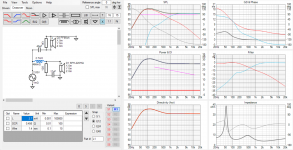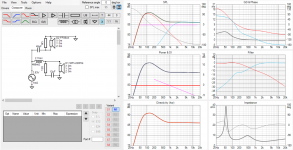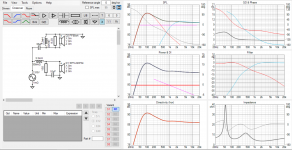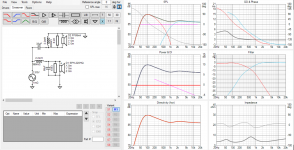One of the things we were trying to achieve is to incorporate BSC compensation without adding in too many components. The baffle width would be 30cm and therefore a 900Hz Xover might introduce BSC thats too high in freq. Do you have any insight into why we have the bulge?
Because the mid driver isn't rolled off enough. If you go to ~900 Hz it should flatten the bulge, but will of course shift the BSC point a bit higher, though at a shallower rising rate, so consider it a plus IME.
GM
GM
So how do we go from here ? There are many ways to bring the XO to 900Hz, but I expect few elegant ways to do it.
Is it OK to tweak also the values of the zobel components ?
Is it OK to tweak also the values of the zobel components ?
Well depends if you think you will go ahead with this particular project. You've got your other Fostex to look at also. They may work well with the simple 1.5 way setup and with the wider bandwidth on the bottom end could work well at a 400Hz 1st order xover.
You could proceed with the current project as it is, 1dB isn't much when you consider the wobbliness of most full range driver FRs and just tweak the values to see if you make it better.
You could go to a 900Hz xover and see how that looks.
You could try a 2nd order (12dB) xover.
You could try a 1st order series xover.
You could proceed with the current project as it is, 1dB isn't much when you consider the wobbliness of most full range driver FRs and just tweak the values to see if you make it better.
You could go to a 900Hz xover and see how that looks.
You could try a 2nd order (12dB) xover.
You could try a 1st order series xover.
I think I'd like to go on with FAST.
As for bass options, I can :
As for FR options, I can :
I am not too confident as these are my first step into audio altogether, so I welcome any subjective or would-be objective advice on these matters.
Thank you !
As for bass options, I can :
- Purchase a second SPH-220HQ, and do 28l stuffed (max flat alignment is 38l)
- Purchase a pair of SPH-8M and do 16l stuffed
As for FR options, I can :
- Get a pair of FF85wk, as they have excellent press
- Source another FR, from Monacor maybe
- Use a pair of TB W3-316B I have at hand
- Use a pair of Dayton PS95 I have on shelf but purchased to do a pair of BOBinGA with
I am not too confident as these are my first step into audio altogether, so I welcome any subjective or would-be objective advice on these matters.
Thank you !
About XO, is it acceptable to invert one driver polarity ? It seems to solve the 1kHz hump, also the phase seems more constant.
Right, whatever makes phase the flattest since to replicate a square wave requires both flat frequency and phase response.
GM
GM
I think I'd like to go on with FAST.
As for bass options, I can :
I would like to keep XO simple though, does that mean I should go with 220HQ ? Also does the flat response mean it would be more flexible for use in different projects ?
- Purchase a second SPH-220HQ, and do 28l stuffed (max flat alignment is 38l)
- Purchase a pair of SPH-8M and do 16l stuffed
As for FR options, I can :
As for XO, I would like to keep it as simple as possible, and use the marketed advantage of 220HQ ie a 1st order.
- Get a pair of FF85wk, as they have excellent press
- Source another FR, from Monacor maybe
- Use a pair of TB W3-316B I have at hand
- Use a pair of Dayton PS95 I have on shelf but purchased to do a pair of BOBinGA with
I am not too confident as these are my first step into audio altogether, so I welcome any subjective or would-be objective advice on these matters.
Thank you !
I didn't realise you didn't have the Fostex yet. If I were you I would look for a well documented project with the drivers you've got OR take on something like this.
10F/8424 & RS225-8 FAST / WAW Ref Monitor
This is similar to what we have been talking about but has been tried tested, measured and there are quite a few builds out there already. There is a sealed version and later a mass loaded transmission line version. He experiments with DSP but there is a passive crossover design.
My project is not documented, I am still experimenting with the crossover but I am just about there. I have previously dabbled with active crossovers which makes things easier in many ways. I have a PA style variable 2 way stereo unit that can connect to a couple of amps. I can then choose the xover frequency and the levels to dial in the BSC. With the cheapness of class D amps these days it makes it a viable option.
Many turn to DSP these days but its not something I've tried.
Last edited:
Thanks.
Also, shouldn't I add a zobel also for the full range ?
Adding a Zobel here might help. You would have to change the 8 ohm parallel also as an extra parallel circuit will reduce the impedance lower.
It may be worth looking at 2nd order as there are not that many components and you wouldn't need a Zobel on the FR at least.
2nd order would help with the lower impedance hump and we may be able to get rid of the parallel 8 ohm altogether.
A series xover may help, we'll look at that later.
Thanks.
Also, shouldn't I add a zobel also for the full range ?
You're welcome!
Depends, the pioneers taught me to solve acoustic problems with acoustic solutions which is contrary to current speaker design theory of adding mass quantities of electronics in series with the signal that often requires one or more zobels to work as basic XO theory predicts.
GM
Thank you both.
I have looked at that thread about 10F8424 & RS225 and I like it (also the Tysen), still I'd like to build something I designed (with help obviously), I already have the SPH-220HQ woofer and I find teh FF85wk also has a lot of documented designs I could try if mine doesn't work.
I found encouraging that they use the exact same filter you suggest : 1st order with 1 zobel network per driver, apparently it is called "transient perfect" !
Speaking of which, I would be happy to get access to the knowledge of pioneers, as I would agree that acoustical solutions are more elegant that electronics, though I expect that route to take longer. GM would you point to resources ?
About DSP/activeXO, I haven't given it much thought. I see it as an easy way out, plus I just bought a (cheap) DAC (Topping e30), and I feel like adding DSP downstream would kill the purpose of a DAC, or am I wrong ?
Anyway, so far I still wish to design a passive XO (as simple as can be).
Edit: I just read that "In practise, nobody uses Zobels in passive crossovers these days except with tweeters. They don't do much, unless you are using a SET valve amplifier which is sensitive to load.". Is it worth it going without it ?
I have looked at that thread about 10F8424 & RS225 and I like it (also the Tysen), still I'd like to build something I designed (with help obviously), I already have the SPH-220HQ woofer and I find teh FF85wk also has a lot of documented designs I could try if mine doesn't work.
I found encouraging that they use the exact same filter you suggest : 1st order with 1 zobel network per driver, apparently it is called "transient perfect" !
Speaking of which, I would be happy to get access to the knowledge of pioneers, as I would agree that acoustical solutions are more elegant that electronics, though I expect that route to take longer. GM would you point to resources ?
About DSP/activeXO, I haven't given it much thought. I see it as an easy way out, plus I just bought a (cheap) DAC (Topping e30), and I feel like adding DSP downstream would kill the purpose of a DAC, or am I wrong ?
Anyway, so far I still wish to design a passive XO (as simple as can be).
Edit: I just read that "In practise, nobody uses Zobels in passive crossovers these days except with tweeters. They don't do much, unless you are using a SET valve amplifier which is sensitive to load.". Is it worth it going without it ?
Last edited:
I would say that with a first order xover a Zobel on the woofer is essential.
If you look at the difference between posts #20 and #22 you will see the effect of the Zobel in the red trace in the Filter window. Without a Zobel the filter stops sloping down at a certain frequency.
The capacitive part of the Zobel counteracts the rising impedance of the drive unit due to the driver's own inductance, which is due to its own coil of wire.
The inductor value is chosen based on the impedance of the drive unit at the Xover frequency which for the Monacor is about 6ohms. However at higher frequencies it nolonger 6 ohms. The Zobel keeps the impedance at a fairly constant level ABOVE the resonant frequency.
Most people don't use a Zobel because most designs don't use 1st order crossovers. Most tweeter based designs use larger order (2nd order or higher).
With a 2nd order filter a Zobel may or may not be useful depending if it achieves the filter response you want.
Have a read of the first few pages of this thread if you haven't yet:
Introduction to designing crossovers without measurement
If you look at the difference between posts #20 and #22 you will see the effect of the Zobel in the red trace in the Filter window. Without a Zobel the filter stops sloping down at a certain frequency.
The capacitive part of the Zobel counteracts the rising impedance of the drive unit due to the driver's own inductance, which is due to its own coil of wire.
The inductor value is chosen based on the impedance of the drive unit at the Xover frequency which for the Monacor is about 6ohms. However at higher frequencies it nolonger 6 ohms. The Zobel keeps the impedance at a fairly constant level ABOVE the resonant frequency.
Most people don't use a Zobel because most designs don't use 1st order crossovers. Most tweeter based designs use larger order (2nd order or higher).
With a 2nd order filter a Zobel may or may not be useful depending if it achieves the filter response you want.
Have a read of the first few pages of this thread if you haven't yet:
Introduction to designing crossovers without measurement
From my fiddling with VituixCAD, it seems that the resistor alone prevents the shelving of the low pass, but of course I miss the understanding of the physics.
Anyway here is my take, with the proper zobel on the woofer (edit : also removing the cap of the zobel kills the 55Hz impedance peak )
I saw another interesting thread close to what we are trying to do :
FF85wk nd RS225-8 passive WAW / FAST
I don't really understand the filetr design though :
Anyway here is my take, with the proper zobel on the woofer (edit : also removing the cap of the zobel kills the 55Hz impedance peak )
I saw another interesting thread close to what we are trying to do :
FF85wk nd RS225-8 passive WAW / FAST
I don't really understand the filetr design though :
- no zobel on the 225 (so the LP shelves and the woofer seems to sum into HF)
- what is the parallel 2.2µ cap for on the 225 ?
- why the resitor on the 225 ?
Attachments
Last edited:
A parallel resistor on a woofer will change the impedance peak which will change its response in a box. A box design will take into account the Q of the speaker which the impedance peak is part of.
The series resistor on the woofer in this project is just the resistance built into the coil of wire of the series inductor. Every inductor has series resistance, usually the lower the better.
No Zobel on the woofer, every rule of thumb can be broken.
The Fostex in this project is in an open baffle i.e. no box so will have a very different response in the low end.
The series resistor on the woofer in this project is just the resistance built into the coil of wire of the series inductor. Every inductor has series resistance, usually the lower the better.
No Zobel on the woofer, every rule of thumb can be broken.
The Fostex in this project is in an open baffle i.e. no box so will have a very different response in the low end.
Last edited:
If you are talking about the two capacitors wired in parallel this just adds together. 57.8uF plus 2.2uF equals 60uF. Its the opposite when it comes to inductors.
I should have known/seen that, sorry.
So do you think the crossover above would work OK ? I have 2 concerns :
So do you think the crossover above would work OK ? I have 2 concerns :
- the impedance peak (I don't know whether it matters or not)
- 1st order on the 85 may not be steep enough to avoid excursion limitation at fs
I think that if you have set your heart on the SPH220HQ and the FF85WK then go ahead and start that project, it can surely be made to work.
The crossover can be developed and changed to suit.
I wouldn't rule out a 2nd order Xover. It would allow a fairly low Xover point without worrying about the 115Hz resonance.
It would probably also negate the need for a Zobel on the woofer.
It may end up at just 5 or 6 components. 4 for the filter and 1 or 2 resistors for attenuation of the FR.
Try 4.8 mH and 33uF for the woofer assuming 6 ohms at 400Hz xover.
Try the same for the FR but put a 24 ohm R in parallel with the FR to bring its Z down from 8 ohms to 6 ohms also.
Using the 8 ohms of the FR will give larger values for the inductor which are usually more expensive.
Don't forget to reverse the polarity connection of one of the drive units relative to the other - this is usually necessary with 12dB filters.
The crossover can be developed and changed to suit.
I wouldn't rule out a 2nd order Xover. It would allow a fairly low Xover point without worrying about the 115Hz resonance.
It would probably also negate the need for a Zobel on the woofer.
It may end up at just 5 or 6 components. 4 for the filter and 1 or 2 resistors for attenuation of the FR.
Try 4.8 mH and 33uF for the woofer assuming 6 ohms at 400Hz xover.
Try the same for the FR but put a 24 ohm R in parallel with the FR to bring its Z down from 8 ohms to 6 ohms also.
Using the 8 ohms of the FR will give larger values for the inductor which are usually more expensive.
Don't forget to reverse the polarity connection of one of the drive units relative to the other - this is usually necessary with 12dB filters.
Last edited:
Thank you both.
1st order with 1 zobel network per driver, apparently it is called "transient perfect" !
I feel like adding DSP downstream would kill the purpose of a DAC, or am I wrong ?
agree that acoustical solutions are more elegant that electronics......would you point to resources ?
Anyway, so far I still wish to design a passive XO (as simple as can be).
Edit: I just read that "In practise, nobody uses Zobels in passive crossovers these days except with tweeters. They don't do much, unless you are using a SET valve amplifier which is sensitive to load.". Is it worth it going without it ?
You're welcome!
Correct.
No clue.
Indeed! Now that excellent performing DSP, etc., is relatively inexpensive, no need for agonizing over basic speaker/system design.
That's a long list of patents, professional technical papers, books the pioneers published as well as more general versions for the DIYer found in DIY various books, magazine articles, etc., but mostly for me it was about reverse engineering/cobbling together mass quantities of 'proofs of concept' of existing speaker designs combined with asking an encyclopedic number of questions along the way to get it dumbed down enough to visualize how it all interacted since I lack the necessary math skills to manipulate the pioneer's driver, various box alignment electrical equivalent ckts. required to create a single driver speaker system, much less a multi-way connected with electrical filters to a considerably more technically complex electrical power/control/distribution system, which of course is now readily available in ~user friendly speaker system design software.
In short, all I've read, been told, done, posted over ~68 yrs is all right here for you [and so much more] in AkAbak or similar plus alignment specific software combined with DIY forums and of course the largest library in history, all of which can be searched in a 'blink of an eye', so do a search and decide for yourself if a zoebel is worth adding in your app [hint: search amp, speaker damping factor].
All that said, going back to the FE126en loaded as a mid speaker with the aforementioned ~900 Hz XO as an example:
Consider sealed up to whatever tuning [Fc] gets flattened by a 1st order ~900 Hz XO, which combined with the cab alignment's slope order allows the driver to now have full use of its 45 W power rating without exceeding its pitifully low Xmax and since it's now a ~500 Hz 2nd order 'acoustic' XO [180 deg out of phase] it will require being wired inverse phase to flatten it out as Stal noted.
Meets the 'flat amplitude, phase' & '5 octave max gain BW', negligible group delay criteria required for excellent music, critical speech reproduction with just a single passive component or DSP setting [I presume].
For me, as simple as it gets without resorting to compression horn loading.
GM
Stal, I'm not sure I properly integrated the values you gave me, because the response looked weird when I tried.
Attached are my tries at :
Attached are my tries at :
- 1st order on both drivers : I think response is good, but afraid it's not safe enough for the 85
- 1st order on woofer, 2nd ordrer on full range
- 2nd order on both : I like that phases seem to match all along, and that impedance has no more peaks
Attachments
- Home
- Loudspeakers
- Full Range
- First project - FAST / WAW like



